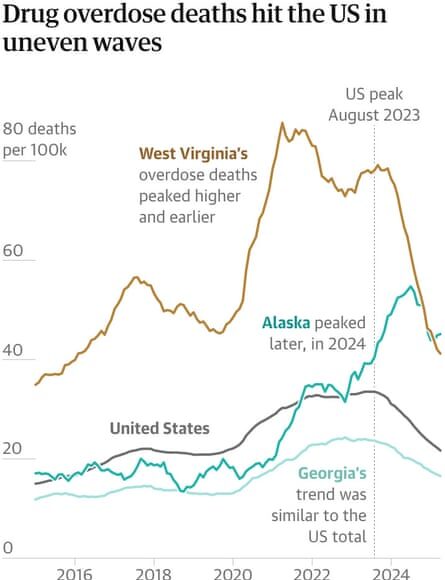Exclusive data analysis reveals wide geographical disparities in the ongoing public health crisis
Methodology: Understanding the Data
To understand the contrasting trends in overdose deaths, the Guardian conducted a comprehensive analysis of several key data points. This multi-faceted approach aimed to identify the underlying drivers behind the varying overdose trends across different regions.
Data Sources Analyzed
- CDC data on overdose fatalities and naloxone distribution
- US Census Bureau data on demographics and socioeconomic factors
- Drug seizure data from the National Forensic Laboratory Information System
- Data from Health, an accredited drug-testing specialty laboratory, examining patterns in substance-use treatment
Regional Disparities: The Numbers Tell Different Stories
While national overdose numbers decreased between August 2023 and December 2024, some US counties experienced a staggering 120% increase during the same period.
State-Level Variations
State-level data through April 2025 revealed a resurgence in deaths starting in January:
States Nearing Peak Levels
- Arizona
States with Moderate Increases
- Delaware
- Hawaii
- Minnesota
- New Mexico
- Washington
These findings emphasize the localized nature of the overdose crisis and the need for targeted interventions in areas where the situation is worsening.
Drug Supply Changes: The Fentanyl Factor
The Guardian’s analysis identified changes in the drug supply, specifically the prevalence of fentanyl and methamphetamine, as significant factors influencing overdose death rates. The geographical distribution of these drugs also played a crucial role.
The Evolution of the Opioid Crisis
1990s: Prescription Opioid Surge
Increased prescription of opioids in the 90s, especially in eastern states such as West Virginia, where physical laborers took pills for their pain.
Early 2010s: Tightened Restrictions
Tightened restrictions on prescription opioids starting in the early 2010s led more people to turn to illegal opioids, such as heroin.
2013: Fentanyl Emerges
Research suggests that fentanyl began replacing heroin in the eastern US in 2013, leading to a westward spread of overdose deaths.
Present: Fentanyl Dominance
Fentanyl, which is cheaper and 70 times more potent, began to replace heroin. DEA factsheets provide additional information on fentanyl.
Naloxone: Life-Saving But Not a Solution
Naloxone, an overdose-reversal drug, is widely recognized for its life-saving potential and is often cited as a key factor in reducing overdose deaths.
The Reality Behind the Statistics
While naloxone undoubtedly saves lives by reversing opioid overdoses, its necessity highlights the severity of the opioid crisis. Every instance where naloxone is required signifies that a person was on the brink of death, emphasizing the need for comprehensive substance-use treatment and mental health support to address the underlying causes of addiction.
SAMHSA provides additional information on naloxone.
Data Gaps: The Information Challenge
Despite improvements in data collection, significant gaps remain in overdose surveillance. Experts emphasize the need for more timely and granular data, similar to the detailed information available during the COVID-19 pandemic.
Current Limitations
Delayed Reporting
The CDC’s overdose death data lags several months behind, hindering real-time responses to emerging trends.
Inconsistent Data Sharing
Inconsistencies in data sharing and analysis of drugs found at overdose scenes further impede efforts to understand and address the crisis effectively.
Limited Granularity
This lack of comprehensive data limits the ability to pinpoint spikes and tailor interventions to specific communities and populations.
A Call for Systemic Change
Experts argue that the focus should shift from solely tracking deaths to addressing addiction as the core issue. They point to the limited data available on addiction compared to other public health crises, such as AIDS.
Learning from History
Drawing parallels to the AIDS epidemic, experts emphasize the importance of prevention and treatment strategies that address the underlying drivers of addiction, rather than simply reacting to overdose deaths.
The Path Forward
By focusing on addiction prevention and treatment, the US can move towards a more sustainable and effective approach to tackling the opioid crisis.
Key Takeaways
The Guardian’s analysis reveals that while national overdose statistics show improvement, the reality on the ground is far more complex. Regional disparities persist, with some communities experiencing significant increases in deaths even as overall numbers decline. Changes in drug supply, particularly the proliferation of fentanyl, continue to drive these trends in different ways across different regions. While interventions like naloxone distribution save individual lives, they cannot address the root causes of addiction. The lack of timely, granular data hampers effective response efforts, and experts call for a fundamental shift in approach—from death prevention to addiction treatment and prevention—to create lasting change in communities across America.




